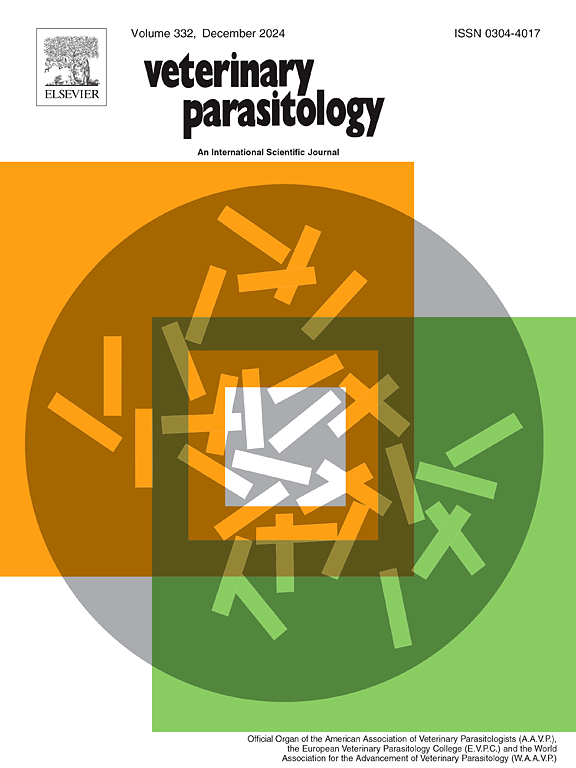角质成分:区分 Argas arboreus 和 Argas persicus 蜱(Acari:Argasidae)的另一种分类方法。
IF 2
2区 农林科学
Q2 PARASITOLOGY
引用次数: 0
摘要
Argas arboreus 和 A. persicus 是埃及家禽的吸血外寄生虫。除了传播各种病原体导致家禽业经济损失外,它们还会导致家禽贫血。由于形态特征较小,非分类学家很难区分这些物种。因此,识别蜱的种类对于制定合适的策略以降低家禽财富风险非常重要。本研究采用气相色谱-质谱法鉴定了两种 Argas 种类的雌性角质层碳氢化合物。在 Arboureus 中专门鉴定出 60 种不同的碳氢化合物,而在 persicus 中仅鉴定出 51 种。其中一些碳氢化合物是区分两个物种的阶段特异性化合物。其他碳氢化合物在两个物种的所有摄食阶段都有,这表明它们是密切相关的物种。两个物种未进食阶段的遗传变异性达到最大值,相似性仅为 25%。本研究首次提供了化学分类学数据,根据角质层碳氢化合物来区分两个亲缘关系很近的 Argas 物种。因此,碳氢化合物成分似乎是一种很有前途的分类特征工具,此外,饲养阶段是易受控制的阶段,这一点也得到了改善。本文章由计算机程序翻译,如有差异,请以英文原文为准。
Cuticular composition: An alternative taxonomic approach to differentiate between Argas arboreus and Argas persicus ticks (Acari: Argasidae)
Argas arboreus and A. persicus are blood sucking ectoparasites on domestic birds in Egypt. They cause anemia in birds, in addition to transmitting a variety of pathogens that leads to economical loss in the poultry industry. It is difficult for non-taxonomists to differentiate between these species because of minor morphological characters. Therefore, it is very important to identify tick species for developing a suitable strategy to reduce risks to poultry wealth. This study characterized the female cuticular hydrocarbons of two Argas species using gas chromatography-mass spectrometry. Sixty different hydrocarbons were exclusively identified in A. arboureus, whereas only 51 in A. persicus. Some of the hydrocarbon compounds were stage-specific ones that differentiate between two species. Others shared between all feeding stages of both species that improved they are closely related ones. Genetic variability recorded its maximum value between unfed stages of the two species, and similarity reached only 25 %. The present study provides the first chemotaxonomic data to differentiate between two closely related Argas species according to their cuticular hydrocarbons. Therefore, hydrocarbon composition seems to be a promising tool available as a taxonomic character, in addition improved that feeding stage was the susceptible one to be controlled.
求助全文
通过发布文献求助,成功后即可免费获取论文全文。
去求助
来源期刊

Veterinary parasitology
农林科学-寄生虫学
CiteScore
5.30
自引率
7.70%
发文量
126
审稿时长
36 days
期刊介绍:
The journal Veterinary Parasitology has an open access mirror journal,Veterinary Parasitology: X, sharing the same aims and scope, editorial team, submission system and rigorous peer review.
This journal is concerned with those aspects of helminthology, protozoology and entomology which are of interest to animal health investigators, veterinary practitioners and others with a special interest in parasitology. Papers of the highest quality dealing with all aspects of disease prevention, pathology, treatment, epidemiology, and control of parasites in all domesticated animals, fall within the scope of the journal. Papers of geographically limited (local) interest which are not of interest to an international audience will not be accepted. Authors who submit papers based on local data will need to indicate why their paper is relevant to a broader readership.
Parasitological studies on laboratory animals fall within the scope of the journal only if they provide a reasonably close model of a disease of domestic animals. Additionally the journal will consider papers relating to wildlife species where they may act as disease reservoirs to domestic animals, or as a zoonotic reservoir. Case studies considered to be unique or of specific interest to the journal, will also be considered on occasions at the Editors'' discretion. Papers dealing exclusively with the taxonomy of parasites do not fall within the scope of the journal.
 求助内容:
求助内容: 应助结果提醒方式:
应助结果提醒方式:


